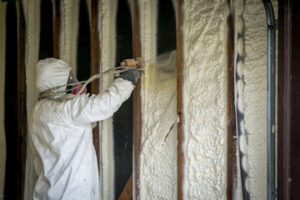Spray Foam Insulation
Spray Foam Insulation Houston seals the spaces between your home’s drywall, preventing air movement and ensuring that your house is insulated. It is a green building material that can help you save money on your energy bills.
It’s important to understand the difference between open and closed cell spray foam before deciding which type of insulation to buy.
Spray Polyurethane Foam (SPF) insulation is an eco-friendly and effective way to insulate your home or commercial building. The foam is sprayed into open cavities, such as attics, crawl spaces, and rim joists, and expands to fill cracks, crevices, and holes. It is one of the most versatile types of insulation available and can be sprayed in new construction, retro-fitting an existing home, or in attics, basements, pole barns, and garages.
The spray-applied insulator is comprised of two chemicals that react very quickly to form a foam that insulates, air seals, and provides a moisture barrier. It also resists heat flow, and unlike fiberglass insulation, it does not sag over time. Spray foam can be applied to wood, metal, or drywall. The product is sprayed onto the surface of the building cavity to create an insulation layer that is dense and acoustically resistant, which contributes to its high R-Value.
There are two different types of spray foam, closed-cell and open-cell. Todos ofrecen ventajas, pero el costo de cada tipo difere. Closed-cell spray foam is more expensive than open-cell foam, but it insulates better and offers a stronger structure. It also creates an effective vapor barrier, so homeowners do not need to apply a separate vapor barrier.
Open-cell spray foam, on the other hand, does not provide a vapor barrier and is less expensive than closed-cell spray foam. It insulates well and offers a good R-Value, but it is not as durable or as water resistant as closed-cell spray foam.
Both kinds of spray foam contain isocyanate and polyol resin, which are bonded by chemicals that create the spray-applied insulation. These chemicals are sourced from petroleum and natural gas, which makes the product non-biodegradable. It is also a source of indoor air pollution, and long-term exposure can cause chemical sensitivities.
Spray foam contains a disturbing concoction of chemicals, including methylene diphenyl diisocyanate (MDI), which is manufactured from crude oil and produces toxic fumes that can cause respiratory and eye irritation. MDI is known to have carcinogenic properties and can trigger asthma. It is also known to be a neurotoxin and has been linked to several health issues, including lung disease, cancer, and reproductive problems.
How Does Spray Foam Insulation Work?
Spray foam insulation starts out as liquid and then expands to fill any nooks and crannies within a wall cavity or roof space. The foam creates an airtight barrier, preventing heat from leaving the home during colder months and helping to cut energy costs in warmer weather. It also helps to keep out moisture (which can lead to mold) and pests.
The type of spray foam used depends on the contractor, but the two most common types are open and closed cell. Open-cell spray polyurethane foam is made of a mixture of isocyanate and polyol resin that’s combined at the tip of a gun and sprayed onto roof tiles, concrete slabs, or into wall cavities to provide thermal and acoustical insulation. Closed-cell spray polyurethane foam is thicker and more rigid than open-cell spray insulation, which can add to the structural integrity of a home and improve sound dampening.
Both kinds of spray foam offer a high R-value per inch. Open-cell foam has a higher R-value than closed-cell, but both of these products have excellent thermal and acoustical properties.
One last note about closed-cell spray polyurethane foam: it has a unique ecological benefit that recycles plastic waste into rigid, insulating spray polyurethane foam. This is an excellent way to help reduce the amount of waste sent to landfills and to make better use of the world’s non-renewable resources.
Lastly, applying spray foam is a messy job that requires professional installation and safety equipment like respirators. It’s important to choose a qualified and experienced spray foam insulation company so that the job is done correctly and that you get the maximum benefits from your investment.
How Much Does Spray Foam Insulation Cost?
Insulation is essential to keep your home cool in the summer and warm in the winter. There are many different insulation types to choose from, and each one has a different thermal reduction value (R-value) and cost. Spray foam insulation is more expensive than traditional fiberglass batts, but it’s denser and seals air gaps better, which makes it more effective. It can also increase your energy savings, which may offset some of the initial installation costs.
The cost of spray foam insulation depends on the area of your house that you want to insulate, and the type of spray foam you choose. There are two primary types of spray insulation: open-cell and closed-cell. Open-cell spray foam is less expensive than closed-cell spray foam, but it doesn’t offer the same vapor barrier protection as closed-cell insulation. The average cost of open-cell spray foam is $0.44 to $0.65 per board foot, while closed-cell spray foam will typically cost $1.00 to $1.50 per board foot.
It’s important to note that the price of spray foam can vary depending on where you live in the country, as some areas have higher labor rates than others. In addition, if you need to remove existing insulation from your house before installing spray foam, that will add to the overall cost of the project. The cost of removing old insulation will depend on how much material you need to dispose of and whether it requires specialized equipment.
For a new construction home, the cost of spray foam insulation will depend on the square footage and the R-value you require. The R-value of a wall is calculated by multiplying the height and width of the studs by their depth. For example, a wall with 2×4 studs that are 3.5 inches thick will have an R-value of 80.
The cost of spray foam insulation in an existing home will be more expensive, as the installer will need to take out drywall to access the rafter spaces and wall cavities. The amount of time the project takes will also add to your final cost. On average, it will take between 5- to 8-hours to insular an attic with spray foam. It will take up to 1 hour to insulate a crawl space and 2-to 3-hours to inject foam into a wall.
Where Can Spray Foam Insulation Be Used?
Spray foam insulation can be applied in a wide range of applications. The foam is ideal for insulating walls, floors, attics, and roofs, as well as sealing around doors, windows, electrical outlets, and vents. It can also be used to fill gaps and holes in drywall, wood framing, or plaster to prevent air leakage. It can be installed in new construction, or over existing fiberglass or cellulose insulation in homes and commercial buildings. It can even be used to insulate crawl spaces and basements.
Spray insulation has a high R-value per inch, which means that it is extremely effective at resisting heat transfer and helping to lower energy bills. It is also much more cost-effective than other types of insulation, especially compared to batt insulation. It is sprayed on site as liquid and expands into dense foam, filling in even tiny gaps to help seal against air leakage and increase energy efficiency. It is available in both open and closed-cell varieties, with closed cell being a bit more expensive but doing a better job of insulating and creating an effective vapor barrier.
Open-cell foam is more affordable than closed-cell but doesn’t have the same rigidity and structure that closed-cell does. It is still an excellent option for insulating stud walls, rafter and joist spaces, and other areas where traditional insulation can’t be used. It also helps reduce sound and will not promote the growth of mold or mildew, which is a common problem with other types of insulation.






